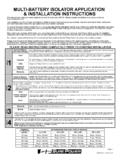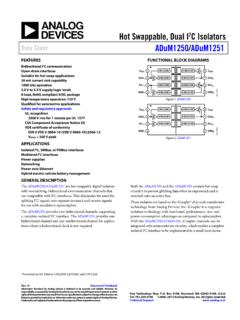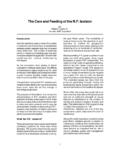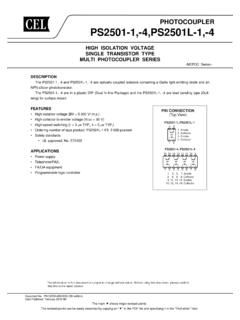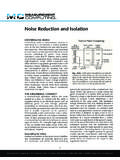Transcription of Grounding and Bonding in the Marine …
1 QUALITY Marine SERVICES, LLC. CAPT. DAVID RIFKIN (USN, RET.), AMS . 904-379-1101, Fax 904-379-1111. Grounding and Bonding in the Marine environment The Case for the Failsafe Galvanic Isolator More than 5 years ago my colleague, Jim Shafer, and I began conducting research in the area of Electric Shock Drowning (ESD) in freshwater environments. These accidents were occurring with little or no explanation, nor understanding, of the exact causes involved. This research, including considerable time in the field, helped us identify the root causes of these accidents, and began our focus on the vital importance of good Grounding and Bonding in the Marine environment . We learned that in all cases involving electrical equipment, the two conditions necessary for an accident are: an electrical fault to ground and a poor or nonexistent Grounding conductor.
2 Provided there is a good, low resistance Grounding conductor installed, an electrical fault to ground will, in most cases, cause a circuit breaker to trip, securing power to the faulty equipment. If the fault current level is too low to trip a circuit breaker, a good Grounding path will at least reduce the voltage touch potentials to a level that should not be dangerous. When the two conditions above occur on a boat, there is a possibility that the underwater metals on the boat could dangerously rise in potential. In this case, the water then becomes the conductor which allows fault current to get back to its source ashore. If a person (in freshwater). gets in the path of this current, they will become a current carrying conductor since a person is far more conductive in the water than the freshwater itself.
3 The result can be a tingle, paralysis causing electric shock drowning (ESD), and electrocution (where the heart's sinus rhythm is directly affected). We also concluded that loss of the shore Grounding conductor creates a danger for people inside the boat. Should an improperly grounded (bonded) piece of equipment ( a water heater). develop a fault such that the heater case rises in voltage, and if a person touches this case and perhaps brushes against the engine block, hull, or other grounded structure, a circuit is competed which can deliver a lethal shock. The fault current path will again include the water segment in this case. Accordingly, in my training classes, public speaking, and in field work, I pay very close attention to the quality of the Grounding connection for the reasons discussed above.
4 After completing dozens of inspections, an area of serious potential trouble was recognized. This area involves the installation of a galvanic isolator in the boat's AC Grounding conductor. This device typically consists of diodes and a capacitor designed to block small DC currents caused by galvanic activity in an effort to minimize corrosion. However, the consequence of failure of one of these isolators, such that the Grounding path becomes open-circuited, establishes one of the two conditions discussed above which lead to accidents. Therefore, it is very important to pay close attention to the design characteristics of any isolator chosen for installation in the vital safety Grounding system. In the many boats I have tested with galvanic isolators, approximately 5% tested open circuited (meaning the boat did not have a connection to the marina Grounding system) and the operators were completely unaware.
5 ABYC Marine ELECTRICIAN & CORROSION INSTRUCTOR. Page 1 of 3. QUALITY Marine SERVICES, LLC. CAPT. DAVID RIFKIN (USN, RET.), AMS . 904-379-1101, Fax 904-379-1111. Given the tens of thousands of isolators installed over the years, there may be thousands out there that have failed open circuited, establishing one of the two necessary accident conditions. One of the problems is that galvanic isolators are seldom routinely tested for proper functioning, if ever. Even those isolators installed today that utilize monitoring may not report accurately if subject to a strong electrical transient (like an ac fault or lightning strike on or near the boat) and sometimes do not work properly even on new installations. Ideally, all boats would receive periodic maintenance that would include a check for a properly functioning galvanic isolator (it is unlikely this will happen any time soon).
6 However, there is a technically sound solution to this problem which came about through the development of a truly fail-safe isolator design that has been in use in the corrosion industry (outside of the boating industry) for years. Isolators not built with fail-safe construction cannot handle the energy associated with a large ac fault or lightning strike and consequently can, and in fact are allowed to, fail open-circuit and still comply with the existing standard. The present standard depends heavily on the monitor to alert a user if a galvanic isolator has failed open circuit, but who knows how long before such a hazard is recognized and corrected, assuming the monitor works properly? With availability of proven fail-safe galvanic isolators that meet and exceed all electrical and mechanical test criteria of the existing or proposed revision to standard A-28 of the American Boat and Yacht Council (ABYC) Standards, galvanic isolators are now available that can be confidently installed in the Grounding conductor between the shore service and the boat's AC panel.
7 In my opinion, insisting on the use of this fail-safe technology, even without a monitor, makes a lot of sense for the following reasons: 1. Since the design is 100% fail-safe, there is no chance that the critical Grounding connection will be lost due to an electrical fault (One fail-safe manufacturer has even verified correct operation with high levels of lightning current, even though lightning current withstand is not a requirement for the existing or proposed revisions to A-28). This represents a significant safety enhancement and reduction in liability for a boat builder, distributor, or installer (especially when, today, plaintiffs are routinely winning large settlements in court where the jury is shown that technology [ , fail-safe galvanic isolators] and more stringent safety criteria [Article 250 in the National Electric Code] existed that could have prevented an accident, but were not utilized).
8 2. Installation of a separate monitoring system will not be required in the upcoming revision to ABYC Standard A-28 only if a fail-safe isolator is used. This means a significant reduction in installation costs since additional wiring is not needed and a monitoring unit need not be fitted and installed (meaning another hole in the panel is not necessary). 3. Since a monitoring unit will not be necessary, the cost of the fail-safe isolator should be comparable to that of the non-fail-safe designs which require the incorporation of a monitoring system. Conclusion: Based on our research and experience, it is imperative that the continuity of the Grounding wire system be intentionally assured at all times. The first step in maintaining this assurance is to install a truly fail-safe galvanic isolator in the boat's AC Grounding wire path.
9 ABYC Marine ELECTRICIAN & CORROSION INSTRUCTOR. Page 2 of 3. QUALITY Marine SERVICES, LLC. CAPT. DAVID RIFKIN (USN, RET.), AMS . 904-379-1101, Fax 904-379-1111. This will greatly enhance safety in the Marine environment , lower liability, and save installation time and associated costs. All these advantages can be realized today at costs comparable to non- fail-safe galvanic isolators. I can be reached at or visit my website at for more information or to answer any questions you may have. ABYC Marine ELECTRICIAN & CORROSION INSTRUCTOR. Page 3 of 3.
